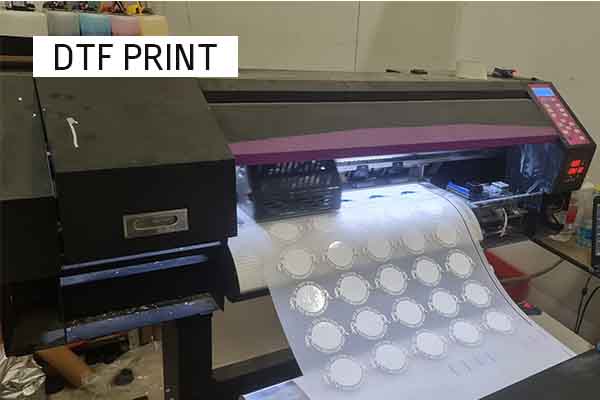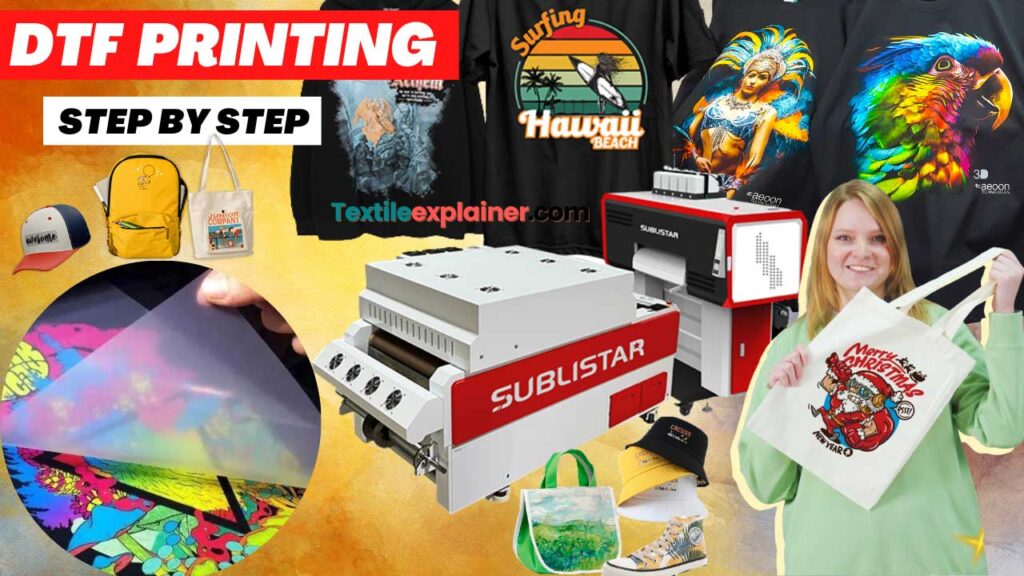Grasping DTF Printing: A Comprehensive Guide to Direct-to-Film Techniques
Grasping DTF Printing: A Comprehensive Guide to Direct-to-Film Techniques
Blog Article
Ultimate Overview to DTF Printing Techniques for Stunning Textile Styles
Getting started on the trip of mastering DTF printing methods can open up a globe of opportunities for developing visually exciting fabric layouts. As the fabric sector proceeds to evolve, staying ahead of the curve with innovative printing methods is vital. In this overview, we will check out the complex information of DTF printing, from realizing the basic essentials to unraveling progressed shade strategies that can boost your layouts to brand-new elevations. Keep tuned as we explore the nuances of choosing the best products, refining the printing procedure, and conquering typical obstacles to attain sensational results.
Recognizing DTF Printing Fundamentals
DTF printing, a process that includes moving styles from an unique movie to fabrics making use of warmth and pressure, develops the foundation of textile printing strategies. The first action in DTF printing entails creating or choosing a layout that will be published onto the fabric.
Once the style is published on the film, it is then thoroughly put onto the textile, guaranteeing appropriate alignment and positioning. The next critical step includes using warmth and stress using a warm press maker. This procedure activates the dyes or pigments on the film, triggering them to sublimate and bond with the textile fibers completely. The result is a magnificent, lasting fabric layout that is cleanable, flexible, and resistant to fading. On the whole, understanding the essentials of DTF printing is important for grasping this contemporary fabric printing strategy.
Selecting the Right Fabric Products
Having actually developed the fundamental principles of DTF printing techniques for textile layouts, the following vital factor to consider exists in selecting the ideal textile materials to match this ingenious procedure properly. The success of a DTF print greatly depends on the compatibility between the picked textile and the printing method. When selecting textile products for DTF printing, it is necessary to consider the fabric's make-up, weave, and appearance. Fabrics that function well with DTF printing consist of polyester blends, spandex, nylon, and various other synthetic materials. These fabrics usually have a smooth surface that permits vivid and detailed prints. In addition, the stretchability of these products can fit the heat transfer process associated with DTF printing without misshaping the design. It is recommended to avoid all-natural fibers such as cotton or silk, as they might not produce the same degree of print clearness and sturdiness. By selecting the right fabric materials, developers can optimize the capacity of DTF printing to develop lasting and spectacular textile layouts.

Understanding the Printing Process
To master DTF printing strategies for fabric designs, grasping the printing process is crucial for achieving high-quality and consistent results. The printing procedure in DTF entails numerous vital actions that call for precision and attention to detail. First of all, preparing the art work for printing is critical. This includes ensuring the design is properly sized and positioned for the textile. Next, the style is published onto an unique DTF movie making use of a compatible printer with the best settings to achieve optimal color vibrancy and clarity (DTF Printing). Once the layout is published, it is after that moved onto the textile making use of a warmth press maker. The temperature level, stress, and period of warmth application must be thoroughly managed to guarantee appropriate attachment of the layout to the fabric. Furthermore, understanding the peeling off procedure after warmth pressing is vital to avoid any damage to the design or fabric. By honing each of these action in the printing process, developers can consistently produce durable and stunning fabric styles with DTF printing methods.
Enhancing Styles With Shade Techniques

Additionally, trying out shade gradients can bring a sense of motion and fluidity to the style. By blending colors perfectly, a gradient effect can be achieved, adding a vibrant and contemporary touch to the textile design. Additionally, their website utilizing shade obstructing strategies can develop striking and strong visuals by juxtaposing different solid shades in distinctive areas of the style.
In addition, including metallic or neon shades can give a special and captivating element to the fabric design, making it stand out and show a learn the facts here now sense of vibrancy. When strategically used, these color strategies can raise the overall visual charm of textile styles, making them much more exciting and unforgettable.
Troubleshooting Common DTF Printing Issues
After discovering different shade methods to boost textile designs, it is important to attend to common DTF printing problems that may emerge throughout the manufacturing process. One common concern is bad adhesion, which can arise from incorrect curing temperature levels or times. To solve this problem, make certain that the treating setups are precise which the adhesive utilized is ideal for the details material being published on. Another regular obstacle is color variances, where shades may appear in different ways than anticipated. This can be caused by inaccurate shade accounts or settings in the printing software application. To tackle this, verify the shade setups and profiles to ensure they match the intended design. Furthermore, concerns with image clarity and sharpness can happen as a result of low-resolution photos or improper printing techniques. To address this, always utilize high-grade images and adjust the printing settings for optimal clearness. By being mindful of these common problems and carrying out the essential troubleshooting steps, you can improve the general top quality of your DTF printed textile styles.
Conclusion
Finally, grasping DTF printing techniques is important for creating stunning fabric styles. By comprehending the basics of DTF printing, picking the ideal products, and enhancing styles with color strategies, one can accomplish outstanding outcomes. It is necessary to fix common concerns that may emerge throughout the printing process to make certain a successful outcome. With method and attention to information, one can create beautiful and special fabric designs utilizing DTF printing techniques.
DTF printing, a process that entails transferring styles from an unique film to textiles making use of heat and pressure, creates the structure of textile printing methods.Having actually established the foundational concepts of DTF printing strategies for textile designs, the following critical consideration exists in picking the websites suitable fabric products to enhance this innovative procedure effectively. By selecting the best fabric products, designers can take full advantage of the potential of DTF printing to create resilient and magnificent textile styles.
To succeed in DTF printing techniques for textile styles, understanding the printing process is necessary for achieving consistent and top notch results. DTF Printing. By honing each of these steps in the printing process, designers can regularly create magnificent and resilient textile styles with DTF printing strategies
Report this page